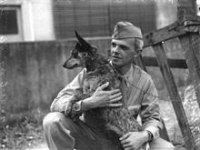In the 1940s Alan McNiven, a Sydney veterinarian, introduced Dingo, Kelpie, German Shepherd, and Kangaroo Hound into his breeding program; however, the Royal Agricultural Society Kennel Club (RASKC) would not register the cross breeds as Australian Cattle Dogs, even though McNiven argued they were true to conformation, colour and temperament. McNiven responded by giving his pups registration papers from dead dogs, and was consequently expelled from the RASKC and all of his dogs removed from the registry. Meanwhile, Greg Lougher, a Napa, California cattle rancher who met Alan McNiven while stationed in Australia during World War II, had imported several adults and several litters from McNiven. After his de-registration McNiven continued to export his 'improved' dogs to the US. Many US soldiers who were stationed in Queensland or NSW during the War discovered the Australian Cattle Dog and took one home when they returned.
In the late 1950s a veterinarian in Santa Rosa, California, Jack Woolsey, was introduced to Lougher's dogs. With his partners, he bought several dogs and started breeding them. The breeders advertised the dogs in Western Horsemen stating they were guaranteed to work and calling them Queensland Heelers. Woolsey imported several purebred Australian Cattle Dogs to add to his breeding program, including Oaklea Blue Ace, Glen Iris Boomerang and several Glen Iris bitches. The National Stock Dog Registry of Butler, Indiana, registered the breed, assigning American numbers without reference to Australian registrations.
 The 9th Australian division mascot being bathed in preparation for a visit by General Douglas MacArthur
The 9th Australian division mascot being bathed in preparation for a visit by General Douglas MacArthur
Australian Cattle Dogs had been classified in the "miscellaneous" category at the American Kennel Club (AKC) since the 1930s; to get the breed full recognition, the AKC required that a National Breed Parent Club be organised for promotion and protection of the breed.
In 1967 Esther Ekman met Chris Smith-Risk at an AKC show, and the two fell into conversation about their Australian Cattle Dogs and the process of establishing a parent club for the breed. By 1969 the fledgling club had 12 members and formally applied to the AKC for instructions. One of the requirements was that the Club had to start keeping its own registry for the breed and that all dogs on the registry would have to be an extension of the Australian registry, tracing back to registered dogs in Australia.
The AKC Parent Club members began researching their dogs, including exchanging correspondence with McNiven, and discovered that few of them had dogs that could be traced back to dogs registered in Australia. The AKC took over the club registry in 1979 and the breed was fully recognised in September 1980.
The Australian Cattle Dog Club of America is still active in the promotion of the breed and the maintenance of breed standards. The National Stock Dog Registry continued to recognise Cattle Dogs without prerequisite links to Australian registered dogs, on the condition that any dog of unknown parentage that was presented for registry would be registered as an 'American Cattle Dog', and all others would still be registered as 'Australian Cattle Dogs'.

